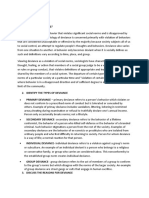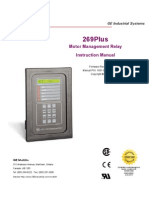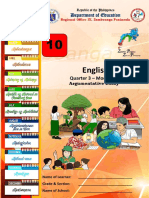0 ratings0% found this document useful (0 votes)
150 viewsCHAPTER 1 - Presentation
CHAPTER 1 - Presentation
Uploaded by
Rhaan Calimutan1. Three emerging subfields of public administration are identified: public enterprise management, voluntary sector management, and spatial information management.
2. Public enterprise management deals with state-run businesses and privatization. Voluntary sector management concerns the effective role of non-profits in delivering public services.
3. Spatial information management uses technology like GPS and remote sensing to efficiently provide public services with location-based data and information.
Copyright:
© All Rights Reserved
Available Formats
Download as PPTX, PDF, TXT or read online from Scribd
CHAPTER 1 - Presentation
CHAPTER 1 - Presentation
Uploaded by
Rhaan Calimutan0 ratings0% found this document useful (0 votes)
150 views8 pages1. Three emerging subfields of public administration are identified: public enterprise management, voluntary sector management, and spatial information management.
2. Public enterprise management deals with state-run businesses and privatization. Voluntary sector management concerns the effective role of non-profits in delivering public services.
3. Spatial information management uses technology like GPS and remote sensing to efficiently provide public services with location-based data and information.
Original Description:
MPA
Copyright
© © All Rights Reserved
Available Formats
PPTX, PDF, TXT or read online from Scribd
Share this document
Did you find this document useful?
Is this content inappropriate?
1. Three emerging subfields of public administration are identified: public enterprise management, voluntary sector management, and spatial information management.
2. Public enterprise management deals with state-run businesses and privatization. Voluntary sector management concerns the effective role of non-profits in delivering public services.
3. Spatial information management uses technology like GPS and remote sensing to efficiently provide public services with location-based data and information.
Copyright:
© All Rights Reserved
Available Formats
Download as PPTX, PDF, TXT or read online from Scribd
Download as pptx, pdf, or txt
0 ratings0% found this document useful (0 votes)
150 views8 pagesCHAPTER 1 - Presentation
CHAPTER 1 - Presentation
Uploaded by
Rhaan Calimutan1. Three emerging subfields of public administration are identified: public enterprise management, voluntary sector management, and spatial information management.
2. Public enterprise management deals with state-run businesses and privatization. Voluntary sector management concerns the effective role of non-profits in delivering public services.
3. Spatial information management uses technology like GPS and remote sensing to efficiently provide public services with location-based data and information.
Copyright:
© All Rights Reserved
Available Formats
Download as PPTX, PDF, TXT or read online from Scribd
Download as pptx, pdf, or txt
You are on page 1of 8
( MPA 103 )
EMERGING SUBFIELDS OF PUBLIC
ADMINISTRATION
Public Administration is an ever-changing scholarly and
professional field. As such, there are new subfields emerging,
which are: public enterprise management, voluntary sector
management, and spatial information management.
Emerging
Subfields of
PUBLIC
ADMINISTRATION
Public Voluntary Spatial
Enterprise Sector Information
Management Management Management
1. Public Enterprise Management: The term public
enterprise denotes a form of human activity operated and managed
by the state government or any public authority. It is an undertaking
where the investment is owned and controlled by any government
organization whether national or local. Thus, public enterprise gained
momentum during the 20th century. In the Philippines, privatization
becomes an area of public administration in the 1980s.
2. Voluntary Sector Management: The role of the voluntary
sector in the delivery of public good has become one special concern
of public administration. Voluntary sectors like the civil society and
nonprofit organizations or the nongovernmental organizations have
also become effective alternative service providers in the community
development programs.
3. Spastial Information and Management: Brillantes, et
al., stressed that in delivering public goods and services
efficiently or effectively, it is very important that we will be
aided with support tools enabling the use of all kinds of spatial
data/information which can be processed immediately and can
be transported easily. This technology is currently used by many
government agencies and corporations, thus the introduction
and popularization of some technology terms in government
such as e-government, e-commerce, geo-visualization, e-finance,
and among others. Other systems are also introduced in system
information management like global positioning systems and
remote sensing.
.
PUBLIC ADMINISTRATION
AS AN ART AND AS A SCIENCE
It can be said that Public Administration is an art of government
in terms of the conduct and management of public affairs; in terms of
dealing with bureaucratic inefficiencies and red tape; in terms of
implementation of public policies and programs; and the use of
resources for public good.
American and British scholars believed that administration is an
art better learned in practice than in school, where basic preparation
is enough to go a long way. PA as an art is an activity that can be
improved or enhanced by one‘s experience gained through practice,
training skills, and responsive insights applied to a particular situation.
Such application through practice of creativity however may prove
futile unless interpreted and evaluated by a researcher.
Science, on the other hand, assumes that its object of
inquiry is amenable to scientific method, e.g., to explicit theory,
empirical research, logical, and even quantitative analysis.
Consequently then, PA is also a science because knowledge is
generated and evaluated according to scientific method.
Thus, Bautista et al., (1993) stated:
At its best, knowledge in PA is or should be useful for a
variety of purposes. It must inform our understanding of classes
and interrelationships of policy and administrative phenomena
through appropriate description and explanation of trends,
events, or behaviors, the conditions under which they obtain and
the variable relations involved. Such understanding must be based
on the interpretative framework of theory or if one likes, “ the
informing grace of ideology. ” In turn, it must provide the basis and
contain the critical elements needed for evaluating the relative
weighs, concomitants, and consequence of administrative events
or actions.
Furthermore, knowledge in PA must be sufficiently
cumulative to enable one to predict such consequences, and to
prescribe action to enable the subject to control and influence
the cause and outcomes of events. The crucial tools of
evaluation and prescription require a clear conception of the
elements of values and purposes (as ell as an eye on motives and
means) as independent variables, criteria of judgment or
objective functions. The difficulties of these tasks are
accentuated by the various roles which the student of PA may
play as a researcher, critic or advocate. (p.41)
Ocampo (1993) in Bautista et al., citing R. Thomas said,
Public Administration can be made into a science, and that the
scientific study of administration leads to the discovery of
principles of administration, which principles in turn determine
the way in which the goals of economy and efficiency can be
realized.
On the other hand, British doctrines argued that
administration cannot be reduced to science alone. It is based on
science and ethics and this combination constitutes a philosophy
of administration. Moreover, the philosophical study of
administration leads to the discovery not only of scientific
principles but also of ethical ideas, which include a qualitative
rather than quantitative kind of efficiency due to the ethical
element explicitly introduced by philosophy.
As reported by:
DARLENE JOSEFINA P. ACEDO
GROUP I
You might also like
- Condor Scissors Lift v2033xl 92350 Parts BookDocument20 pagesCondor Scissors Lift v2033xl 92350 Parts Booksusan100% (58)
- Rosenbloom Et Al, Chapter 1Document44 pagesRosenbloom Et Al, Chapter 1Dutu Sorin Iulian75% (4)
- PDF Alfiler 1999 The Philippine Administrative SystemDocument5 pagesPDF Alfiler 1999 The Philippine Administrative SystemRenz Isidoro100% (1)
- PPA Lesson 1Document10 pagesPPA Lesson 1Djay EspiloyNo ratings yet
- Complete English Pedagogy For CTET NotesDocument56 pagesComplete English Pedagogy For CTET NotesSamir Mandal67% (6)
- Report - The Philippine Administration System - Its Components and Power BaseDocument22 pagesReport - The Philippine Administration System - Its Components and Power BaseJohn VincentNo ratings yet
- E GovernanceDocument31 pagesE GovernanceNashiba Mastura50% (2)
- Lesson 5 Public Administration Its Loco-Focal Metamorphosis PDFDocument6 pagesLesson 5 Public Administration Its Loco-Focal Metamorphosis PDFLorienelNo ratings yet
- PA 200 Theory of PA Final Exam JM Castino AnswersDocument6 pagesPA 200 Theory of PA Final Exam JM Castino Answersnitotalib0% (1)
- Revenue Administration in The Philippines Significant Collection Reforms, TRAIN Law, Fiscal Incentives, Excise Tax, and Rice Tariffication LawDocument8 pagesRevenue Administration in The Philippines Significant Collection Reforms, TRAIN Law, Fiscal Incentives, Excise Tax, and Rice Tariffication LawKent Elmann CadalinNo ratings yet
- To Whom Is P.ADocument1 pageTo Whom Is P.ALDRRMO RAMON ISABELANo ratings yet
- Assignment 1 - Gov and DevtDocument3 pagesAssignment 1 - Gov and DevtTin PrimeNo ratings yet
- SUMMARY REVIEW GovernanceDocument3 pagesSUMMARY REVIEW GovernanceMegumiTakamiyaNo ratings yet
- E-Governance For DevelopmentDocument83 pagesE-Governance For DevelopmentLiana Lyn GunaoNo ratings yet
- E-Governance Chapter 3Document20 pagesE-Governance Chapter 3Manasa M RNo ratings yet
- 1524Document63 pages1524joelbunomendozaNo ratings yet
- Graft & Corruption in The GovernmentDocument19 pagesGraft & Corruption in The GovernmentNi CaNo ratings yet
- Systems Development in Is ResearchDocument10 pagesSystems Development in Is ResearchJayaletchumi MoorthyNo ratings yet
- Building Good Governance in IndonesiaDocument18 pagesBuilding Good Governance in Indonesiabrilliant76No ratings yet
- PpaDocument4 pagesPpaKyla JNo ratings yet
- 2 - The History of Public Administration and The Dichotomy Between Politics and AdministrationDocument10 pages2 - The History of Public Administration and The Dichotomy Between Politics and Administration太陽月No ratings yet
- Ethic and AccountabilityDocument3 pagesEthic and AccountabilityShahril BudimanNo ratings yet
- Department of Finance Hand OutDocument9 pagesDepartment of Finance Hand OutJonathan RiveraNo ratings yet
- Is There A Philippine Public Administrat PDFDocument63 pagesIs There A Philippine Public Administrat PDFRona MayNo ratings yet
- Presentation of USAID Compete Chief of Party DR Enrico BasilioDocument10 pagesPresentation of USAID Compete Chief of Party DR Enrico BasilioPortCallsNo ratings yet
- Administrative Reform: James Iain Gow, Emeritus Professor Université de MontréalDocument4 pagesAdministrative Reform: James Iain Gow, Emeritus Professor Université de Montréaldafa asidiqNo ratings yet
- Fiscal AdministrationDocument141 pagesFiscal AdministrationJess M PauliteNo ratings yet
- Module 2 Intro. To P.A.Document6 pagesModule 2 Intro. To P.A.Rosalie MarzoNo ratings yet
- Issues of Development Administration - MidsemDocument8 pagesIssues of Development Administration - MidsemVictor BrownNo ratings yet
- DA1 - Graft and CorruptionDocument8 pagesDA1 - Graft and CorruptionShaneBattierNo ratings yet
- Alex Brillantes Jr.Document69 pagesAlex Brillantes Jr.anon_531265714No ratings yet
- Public Administration in The Philippines Is There A Public Administration?Document6 pagesPublic Administration in The Philippines Is There A Public Administration?Sam PertsNo ratings yet
- Essay About The Current Face of The Philippine Public AdministrationDocument4 pagesEssay About The Current Face of The Philippine Public Administrationzam fernandez100% (1)
- Administrative History As A Core Dimension of Public AdministrationDocument32 pagesAdministrative History As A Core Dimension of Public AdministrationfamastarNo ratings yet
- Public DebtDocument2 pagesPublic DebtRonnie TambalNo ratings yet
- Postmodern Public Administration in The Philippines: Perspectives, Problems and ProspectsDocument23 pagesPostmodern Public Administration in The Philippines: Perspectives, Problems and ProspectsChristian ErrylNo ratings yet
- Public AdDocument4 pagesPublic AdGail CariñoNo ratings yet
- Definitions of Public AdministrationDocument14 pagesDefinitions of Public AdministrationDayyanealos100% (1)
- Ethics in The Government ServiceDocument7 pagesEthics in The Government ServiceIvan BalagotNo ratings yet
- Admin Law Module 1Document8 pagesAdmin Law Module 1Bernice ZoeNo ratings yet
- The Bangsamoro Peace ProcessDocument2 pagesThe Bangsamoro Peace ProcessBeatrice BaldonadoNo ratings yet
- New Public AdministrationDocument8 pagesNew Public AdministrationKushagra AwasthiNo ratings yet
- Part Iithe Development of Public FinanceDocument6 pagesPart Iithe Development of Public FinanceJo Che RenceNo ratings yet
- Public Versus Private AdministrationDocument3 pagesPublic Versus Private AdministrationAnonymous T5v5yESz0No ratings yet
- Part Ii The Environment of Public AdministrationDocument11 pagesPart Ii The Environment of Public AdministrationJoseph Ryan Marcelino0% (1)
- Public Fiscal Administration Part 1-1Document10 pagesPublic Fiscal Administration Part 1-1phoebeNo ratings yet
- Spoils System in Philippine Bureaucracy: The Assassin of Political NeutralityDocument15 pagesSpoils System in Philippine Bureaucracy: The Assassin of Political NeutralityAMNANo ratings yet
- PM Ra 11032 Written Report by John Carlo CapawaDocument16 pagesPM Ra 11032 Written Report by John Carlo CapawaJohn Carlo JoCapNo ratings yet
- Role of Public Administration in Good Governance PDFDocument4 pagesRole of Public Administration in Good Governance PDFMary Mhelbone Banao100% (2)
- PA 121 - PeñalosaDocument7 pagesPA 121 - PeñalosaKathleen Ebilane PulangcoNo ratings yet
- The Meaning of Public AdministrationDocument43 pagesThe Meaning of Public AdministrationChickenNo ratings yet
- PA11Finals PDFDocument22 pagesPA11Finals PDFmedraYEAHNo ratings yet
- MPA-Local GovernanceDocument2 pagesMPA-Local GovernanceRein DrewNo ratings yet
- Public Private Partnership - PPT - OutlineDocument3 pagesPublic Private Partnership - PPT - OutlineJ Ja50% (2)
- Evolution of Philippine Public AdministrationDocument2 pagesEvolution of Philippine Public AdministrationSam PertsNo ratings yet
- By Ledivina V. Cariño: Zenaida L. Paday-Os Josefina B. Bitonio, DpaDocument44 pagesBy Ledivina V. Cariño: Zenaida L. Paday-Os Josefina B. Bitonio, Dpamary grace degorioNo ratings yet
- Nature of Development Economics: Is Concerned Primarily With The Efficient, Least-CostDocument2 pagesNature of Development Economics: Is Concerned Primarily With The Efficient, Least-CostRio AlbaricoNo ratings yet
- BSSD103 - GOVERNANCE & DEVELOPMENT Assignment 1Document7 pagesBSSD103 - GOVERNANCE & DEVELOPMENT Assignment 1TatendaNo ratings yet
- Public-Private Partnership in The PhilippinesDocument13 pagesPublic-Private Partnership in The PhilippinesCarlos Rabago100% (1)
- Policy Actions for COVID-19 Economic Recovery: A Compendium of Policy BriefsFrom EverandPolicy Actions for COVID-19 Economic Recovery: A Compendium of Policy BriefsNo ratings yet
- 2022-12-31Document365 pages2022-12-31Durjoy DasNo ratings yet
- List of Agencies With Recognition Status and ApplyingDocument7 pagesList of Agencies With Recognition Status and ApplyingReginNo ratings yet
- Alternative Therapies: Arce, Kimberly Bagni, Farah Jelimae Castro, Veronica Dorion, Gelza ErikaDocument27 pagesAlternative Therapies: Arce, Kimberly Bagni, Farah Jelimae Castro, Veronica Dorion, Gelza ErikaFarah Jelimae BagniNo ratings yet
- R-60 To R-60: Zoning ComparisonDocument1 pageR-60 To R-60: Zoning ComparisonPlanning DocsNo ratings yet
- Question No. 1 Is Compulsory. Attempt Any Four Questions From The RestDocument2 pagesQuestion No. 1 Is Compulsory. Attempt Any Four Questions From The Restsahil kumarNo ratings yet
- NARA - T733 - R4 - 62 (Records of German Field Commands Corps (Part VII) )Document242 pagesNARA - T733 - R4 - 62 (Records of German Field Commands Corps (Part VII) )V ManNo ratings yet
- Open Sample SCI1020Document20 pagesOpen Sample SCI1020JoeNo ratings yet
- Print OPD Reg. Card: DR Baba Saheb Ambedkar Hospital RohiniDocument2 pagesPrint OPD Reg. Card: DR Baba Saheb Ambedkar Hospital RohiniSaxenaNo ratings yet
- Pricing:: Approaches and StrategiesDocument20 pagesPricing:: Approaches and StrategiesAshik Ahmed NahidNo ratings yet
- Pe Tutorial 2 PDFDocument10 pagesPe Tutorial 2 PDFkibrom atsbhaNo ratings yet
- Brochure Seminar - NavIC - The Game ChangerDocument6 pagesBrochure Seminar - NavIC - The Game ChangerKumar Rbk RbkNo ratings yet
- New Defence PolicyDocument40 pagesNew Defence PolicyStuff NewsroomNo ratings yet
- Em 2 Chapter 3Document51 pagesEm 2 Chapter 3Sudhanshu SinghNo ratings yet
- The Witches of Durer and Hans Baldung GrienDocument37 pagesThe Witches of Durer and Hans Baldung GrienDanys ArtNo ratings yet
- Catalagram: A Refining Technologies PublicationDocument44 pagesCatalagram: A Refining Technologies PublicationMón Quà Vô GiáNo ratings yet
- Fireforge Games CreditorsDocument48 pagesFireforge Games CreditorsMichael FutterNo ratings yet
- What Is DevianceDocument4 pagesWhat Is DevianceellaNo ratings yet
- Hitachi RAC-70YH7 Service ManualDocument92 pagesHitachi RAC-70YH7 Service ManualHoang Anh LeNo ratings yet
- Sample MCQ 'S Biotechnology DepartmentDocument50 pagesSample MCQ 'S Biotechnology DepartmentSaurabh Kumar RawatNo ratings yet
- I'Ll Start My Diet Tomorrow - A Solution-Focused Approach To Weight LossDocument8 pagesI'Ll Start My Diet Tomorrow - A Solution-Focused Approach To Weight Losssolutions4familyNo ratings yet
- A Strange Way To Save The WorldDocument6 pagesA Strange Way To Save The Worlddaniel_1973No ratings yet
- 269plus: Motor Management Relay Instruction ManualDocument212 pages269plus: Motor Management Relay Instruction ManualRino MalNo ratings yet
- Components of HighwayDocument15 pagesComponents of Highwayjong Lac100% (2)
- Vastu: Breathing Life Into Space by Robert E. Svoboda Ebook: Download Book HereDocument3 pagesVastu: Breathing Life Into Space by Robert E. Svoboda Ebook: Download Book HereAman RambaniNo ratings yet
- The Khyber Pakhtunkhwa Wildlife and Biodiversity Protection Preservation Conservation and Management Act 2015Document43 pagesThe Khyber Pakhtunkhwa Wildlife and Biodiversity Protection Preservation Conservation and Management Act 2015Hashim ShahzadNo ratings yet
- Options To Improve The Action of PROTACs in Cancer Development of Controlled Delivery NanoparticlesDocument13 pagesOptions To Improve The Action of PROTACs in Cancer Development of Controlled Delivery NanoparticlesHan GaoNo ratings yet
- ARIMA PaperDocument3 pagesARIMA PaperroziahzailanNo ratings yet
- English: Department of EducationDocument16 pagesEnglish: Department of EducationCristina BalongcasNo ratings yet

























































































